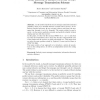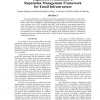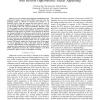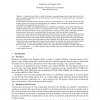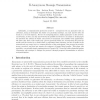SOCIALCOM
2010
13 years 10 months ago
2010
Abstract--In both the commercial and defense sectors a compelling need is emerging for rapid, yet secure, dissemination of information. In this paper we address the threat of infor...
JOC
2007
14 years 9 days ago
2007
This paper is about the Oblivious Transfer in the distributed model proposed by M. Naor and B. Pinkas. In this setting a Sender has n secrets and a Receiver is interested in one o...
EUROCRYPT
2008
Springer
14 years 2 months ago
2008
Springer
In the model of perfectly secure message transmission schemes (PSMTs), there are n channels between a sender and a receiver. An infinitely powerful adversary A may corrupt (observe...
CEAS
2008
Springer
14 years 2 months ago
2008
Springer
With the amount of unsolicited emails on the rise, domain authentication schemes have been widely deployed to identify senders. Establishing a sender's identity does not guar...
LISA
2007
14 years 2 months ago
2007
We propose RepuScore, a collaborative reputation management framework over email infrastrucure, which allows participating organizations to establish sender accountability on the ...
WCNC
2010
IEEE
14 years 4 months ago
2010
IEEE
—In most existing sender-initiated handshaking based underwater Media Access Control (MAC) protocols, only the initiating sender is allowed to transmit data packets to its intend...
ATVA
2007
Springer
14 years 4 months ago
2007
Springer
A fair non-repudiation protocol should guarantee, (1) when a sender sends a message to a receiver, neither the sender nor the receiver can deny having participated in this communic...
EUROCRYPT
2010
Springer
14 years 5 months ago
2010
Springer
A broadcast protocol allows a sender to distribute a message through a point-to-point network to a set of parties, such that (i) all parties receive the same message, even if the s...
ACSAC
2002
IEEE
14 years 5 months ago
2002
IEEE
The Solar Trust Model provides a method by which the sender of a message can be authenticated, and the level of trust that can be placed in the sender of the message or the messag...
CCS
2003
ACM
14 years 5 months ago
2003
ACM
Informally, a communication protocol is sender k - anonymous if it can guarantee that an adversary, trying to determine the sender of a particular message, can only narrow down it...

